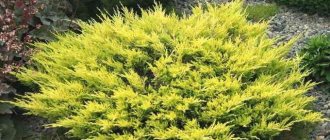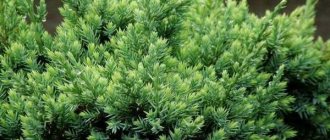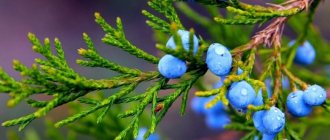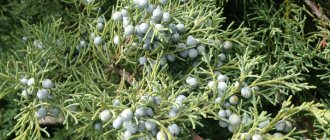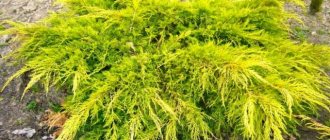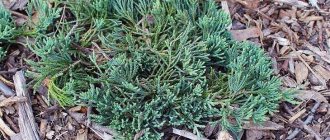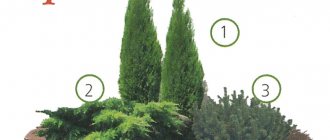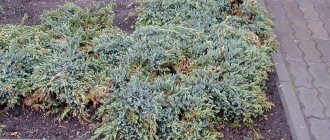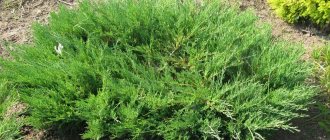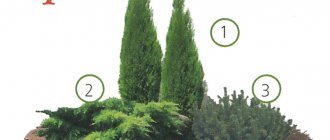Coniferous trees, majestic and creeping, create a special dynamic in the garden, fill it with phytoncides and maintain the composition throughout the year. Among conifers, the most useful for releasing phytoncides is juniper. Its varied shapes and colors allow you to create beautiful rockeries and add them to flower beds. And the beneficial elements it contains have long been used by humans in folk medicine. It was endowed with mystical properties: the room was fumigated with juniper branches and kept behind icons.
Juniper is widespread in the northern hemisphere: from the subtropics to the tundra. It has adapted to the harshest conditions, withstanding low temperatures and supporting scree of infertile soils with its roots. There are about 70 species of juniper belonging to the Cypress family.
Chinese juniper is one of the most beautiful members of the family, which has been used as plants for the art of bonsai for thousands of years. In Western Europe it was first described in 1804. It has been cultivated in the near abroad since 1850 in the Nikitsky Botanical Garden. The southern regions of Russia are perfect for this species. It can be found on the rocky plateaus of the Crimea and the Caucasus. Dry seasons in the south of Crimea affected the population, but otherwise the species has adapted well there.
Description
Chinese juniper is widespread in southern Manchuria, China, Japan and Korea.
Forms shrubs and trees up to 20-25 m in height. Depending on the variety, the crown is columnar, pyramidal or creeping. The shoots are dark green, covered with scaly and needle-shaped needles. On young shoots of the first year, the needles are flat (about 3 mm), and on last year’s parts of the branches the needles become more rigid, needle-shaped (up to 12 mm). The cones are covered with a bluish coating up to 9 mm in length. The cones ripen in the second year: the seeds acquire a brown color and a triangular or elongated shape.
In the first years of life, the plant suffers from low winter temperatures and requires shelter in the Moscow region. An adult plant tolerates temperatures down to -30 degrees.
Perfect for growing in cities, does not suffer from polluted air. It also easily takes root on the steppe slopes of southern Russia. Needles can suffer only in the first years of life: from dry air and severe frosts. With minimal care, a tree can live up to 100 years without losing its decorative appearance.
Chinese juniper and its varieties in the photo
Botanical name: Chinese juniper.
The homeland of Chinese juniper: northeastern China, Manchuria, Japan, North Korea.
Lighting: light-loving.
Soil: undemanding to soil fertility.
Watering: drought-resistant, watering during dry periods no more than 1-2 times a month.
Maximum tree height: 20-25 m.
Average lifespan of a tree: 800 years.
Planting: seeds and cuttings, creeping forms by layering.
Description
Chinese juniper (lat. Juniperus chinensis) is a species of plants belonging to the genus Juniper of the Cypress family. These are monoecious or dioecious trees or shrubs, reaching a height of 20-25 m. The trees have a narrow-cone-shaped, wide-cone-shaped or columnar crown, the shrubs have a creeping, round or pyramidal crown. The shoots of Chinese juniper are usually dark green in color, thin, no more than 2.5 mm in thickness. The bark is gray-red, flaking.

The needles of plants of this species can be either needle-shaped or scale-shaped. The cones, depending on the variety, also have different shapes: angular, elongated or spherical. At the beginning of ripening, they are covered with a whitish coating, then they darken, acquiring a brown, dark blue or black tint. Each cone contains 2 to 4 shiny, brown, elongated or triangular seeds that ripen in the second year.

The Chinese juniper, the photo of which is presented above, got its name because of its distribution area. The homeland of these plants is China, Japan, North Korea. In Western Europe, trees and shrubs of this species began to be cultivated at the beginning of the 19th century. In 1850, the first plants of Chinese juniper appeared in the Nikitsky Botanical Garden (South Coast of Crimea), and then in the botanical gardens of the North Caucasus.
At a young age, Juniperus chinensis grows slowly, then the growth rate accelerates. It is quite frost-resistant, demanding on air humidity, but practically indifferent to air pollution; some varieties can withstand the conditions of the arid steppe and develop well in urban conditions.
Chinese juniper: planting and care
Chinese juniper is widely used both in single and group plantings on lawns, is used to decorate slopes and hills, and looks great in heather and Japanese rock gardens.
When planted by seeds, the first shoots appear only after 1-3 years. Before sowing, seeds need stratification. For a month, the planting material is kept at a temperature of 20-30°C; for the next four months, the seeds are stored at a temperature of 14-15°C. In spring, the seeds should be cleared of pericarp and then scarified (partially breaking the hard covering). Before planting Juniperus chinensis, add some juniper soil to the planting furrows to encourage the spread of mycorrhizae.
It is recommended to plant cuttings in sunny places, since with constant shading the plants lose their decorative qualities, become loose, and the needles may partially fall off. The distance between seedlings depends on the variety of Chinese juniper - columnar trees can be planted at a distance of 0.5 m from each other, shrubs with a spreading crown require a larger area (up to 2 m). The planting depth of Juniperus chinensis is usually 70 cm, while a little soil should be added to the root ball and, if necessary, drainage should be provided (sand and broken brick in a layer of up to 15-20 cm). Large plants are planted in such a way that the root collar of the seedling is 5-10 cm above the edges of the planting hole. It is preferable to purchase planting material with a closed root system. Chinese juniper with open roots is more capricious; such plants can be planted for a very limited time: only in late April - early May or late August - early September, and only in moderately humid weather. Also in this case, it is necessary to treat the exposed roots of the seedling with root formation stimulants. Seedlings from containers are more viable; they can be planted in a permanent place throughout the season, after first soaking the ball of soil with water for two hours.
Trees and shrubs of the juniper genus are undemanding to soil fertility. The most common soil mixture is peat (2 parts), turf soil and sand (one part each). This ratio may vary depending on the plant variety. The optimal soil acidity when planting these plants is from 4.5 to 7 pH.
Caring for Chinese juniper is not difficult. Plants of this type are quite unpretentious and easy to grow. The only thing worth paying close attention to is the prevention of fungal diseases, as well as protection from the spring burning of pine needles. For preventive purposes, with the onset of the warm season, 30-40 g/m2 of nitroammophosphate should be added to the soil.
Since Juniperus chinensis does not tolerate dry air well, the tree crown should be sprayed regularly (once a week in the evening), but you should not worry about frequent watering. During dry seasons, trees and shrubs should be watered no more than once a month. After watering, it is recommended to lightly loosen and weed the circle around the trunk. For the winter, the soil can be mulched with wood chips, peat or sawdust. Haircut and pruning of the crown are carried out depending on the place of cultivation - in landscape plantings this should be done regularly, in hedges it is enough to remove dry branches.
Caring for columnar Chinese juniper involves tying up the branches in winter to avoid damage from heavy snow. Only young plants should be covered during the cold period; mature trees and shrubs are quite frost-resistant. If necessary, the tree trunk circle can be sprinkled with peat or covered with spruce branches.
Varieties of Chinese juniper - “Stricta”, “Blue Alps” and others
Chinese juniper "Stricta" (Juniperus chinensis Stricta) is a dense conical shrub with a columnar or narrow pin-shaped crown. At 10 years of age, the Stricta plant variety can reach 1.5 m in height with a crown diameter of up to 0.7 m. The shoots grow strictly vertically. The needles on thick, ascending branches have a gray or bluish-green tint. The cones are purple-brown, spherical. This variety is very frost-resistant, even in the harshest winters it does not require additional insulation, however, like other plants of this species, it does not tolerate frequent replanting.
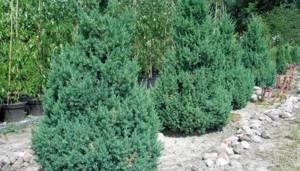
The Chinese juniper variety “Strict” (see photo) is recommended for planting in heather and rocky gardens, looks great both in single and group plantings, and is used to decorate slopes and hills, and decorate lawns.
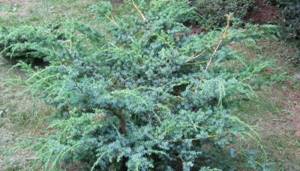
Chinese juniper "Blue Alps" (Juniperus chinensis Blue Alps) is a fairly large plant, reaching 4.5 m in height. The skeletal branches are powerful, the crown is compact, with shoots hanging down. The needles are hard, prickly, up to 1 cm long, silver-bluish in color. Juniperus chinensis Blue Alps is light-loving and frost-resistant; it is very popular among professional landscape designers and amateur gardeners.
The Blue Alps variety grows best in sunny areas; it can be planted on rocky soils and sandstones; it reaches good development in fairly fertile soils. This variety is ideally suited as an exclusive garden bonsai. Chinese juniper Blue Alps is ideal for forming a hedge that can turn into an impenetrable fence.
Blue Alps variety of Chinese juniper
Chinese juniper "Variegata" (Juniperus chinensis Variegata) is a small tree or shrub with a pyramidal shape.
The maximum height at 10 years of age is 2 m. Characteristic features of this form are yellowish-white spots randomly scattered across the blue-green crown. The Variegata variety is quite thermophilic, but with proper care it can also be grown in the climatic conditions of the middle zone. Does not tolerate stagnant waterlogging. In the first 2-3 years, good care is required: protection from direct sunlight and wrapping in winter. Pruning should be carried out before the onset of active sap flow (late April - early May).
In recent years, variable Variegata varieties have become widespread: Chinese juniper “Stricta Variegata” (with splashes of soft cream color) and Chinese juniper “Expansa Variegata” (with splashes of beige color). Thanks to its unusual, spotted color, the Variegata form is used as a bright accent on lawns and in sophisticated landscape compositions.
Juniperus chinensis "Monarch"
Chinese juniper "Monarch" (Juniperus chinensis Monarch) is a tall shrub with an asymmetrical columnar or narrow pin-shaped crown, reaching a height of 1.5-2.5 m.
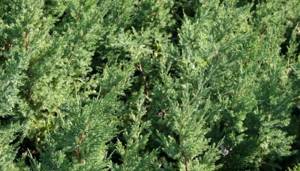
The needles of this variety are extremely fragrant, very prickly, and have a bluish-green or gray color. The main trunk grows strictly vertically, the side branches extend from it at right angles, and then bend to a horizontal position, forming an original silhouette, characteristic only of this variety. The “Monarch” form is unpretentious to soil fertility, quite light-loving, and looks elegant both in single and group plantings.
Chinese juniper "Plumosa Aurea"
Chinese juniper “Plumoza Aurea” (Juniperus chinensis Plumoza Aurea) is a decorative, dwarf form, not exceeding 1 m in height at the age of 10 with the same crown diameter.
In summer, the needles of this variety are golden yellow, and in winter they acquire a brownish tint. The branches extend vertically upward from the trunk and hang down at the ends. This form is undemanding to soils, quite frost-resistant, and achieves best development on fresh and fertile soils.
Plumoza Aurea is one of the most beautiful varieties with yellow needles, recommended for growing in small gardens and rockeries. Mixed compositions with ornamental grasses and flower shrubs are widely used.
"Kurivao Gold" - a beautiful variety of Chinese juniper
Chinese juniper "Kuriwao Gold" (Juniperus chinensis Kuriwao Gold) is a fairly tall, spreading plant, reaching 2 m in height.
The crown is often asymmetrical, the needles are golden-green, openwork. The shoots are directed vertically upward. Despite its impressive size, this variety does not look bulky, thanks to the subtle pattern of the branches.
The plant is very light-loving and develops best in single plantings, when it is not shaded by other trees. In insufficient lighting, it can lose not only the richness of its colors, but also the splendor of its forms.
The “Kurivao Gold” variety is well adapted to urban conditions, does not suffer from air pollution and dry soil, is frost-resistant, and is suitable for growing in containers.
Photo gallery: Chinese juniper (click on the image to enlarge):
udec.ru
Types and varieties of Chinese juniper
Breeders have developed about 50 varieties from Chinese juniper. They differ in the shape of the crown and the color of the needles.
Juniper Stricta
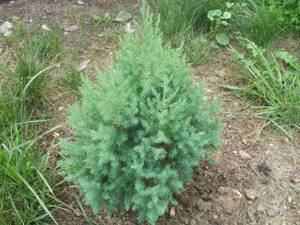
Juniper chinensis Stricta
This group of junipers has an excellent cone-shaped shape and is hardy, which makes it possible to grow even in containers. The tree is not characterized by rapid growth; an adult plant often does not exceed 2.5 m. The needles are colored greenish-gray. In the Variegata variety, the needles, obtained as a result of a random mutation, are cream-colored in places.
Juniper Blue Alps
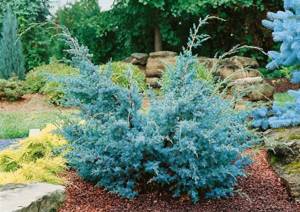
Juniper Blue Alps
A common variety. It is characterized by slow growth and a beautiful spreading crown. The needles are hard (up to 1 cm), colored silver-green. Young, lightly colored shoots are drooping. An adult plant does not exceed 4 m. In snowless winters, it is better to cover the plant. Otherwise, the plant is very hardy, not demanding on soil and direct sunlight. Can grow in partial shade on slightly acidic and neutral soils. In spring, when solar activity increases sharply and the ground has not yet thawed, the plant may get burned. This can be avoided by covering the bush with special material.
Spartan
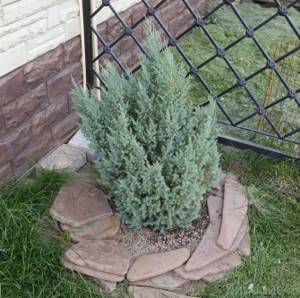
Juniper Chinese Spartan
The variety was bred by American breeders and is endowed with the most frost-resistant qualities among all Chinese junipers. Since 1960, it has been widely used for landscaping urban landscapes. The dense crown, mainly with scaly needles, allows it to be used to give beautiful shapes. Pruning makes the crown even thicker, and an increase of no more than 15 cm allows you to maintain the design.
Mint Julep
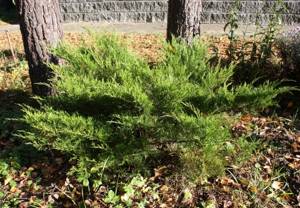
Juniperus chinensis Mint Julep
Refers to shrubs with arched drooping branches. Light green needles are predominantly scaly in shape. With a plant height of 2 m, the area covered by the crown is about 3.5 m. The cone-berries (up to 1.5 cm) are colored dark purple with a bluish bloom. This variety was obtained by crossing Chinese and Cossack juniper. It has retained all the vital qualities of the Cossack juniper, but also the toxicity of all parts of the plant. It takes root well and winters in central Russia and is suitable for the urban landscape.
Old Gold

Juniperus chinensis Old Gold
The variety of Dutch breeders is particularly popular in Russia. This is a small bush with a crown painted in light lime and green colors. The shape of the bush forms a funnel. With a height of an adult plant no higher than 60 cm, it can reach 1 meter in length. For planting, you need to choose a well-lit area with neutral or slightly acidic soil. The plant does not tolerate transplantation well, and can live in one place for up to 100 years.
Kurivao Gold

Juniperus chinensis Curivao Gold
It looks like a spreading bush with upward-pointing branches. An adult plant reaches 2 m in height and width. Every year, 15-20 cm of young growth is formed, colored bright yellow. It looks very impressive against the background of older dark green needles. It tolerates shearing well and is suitable for forming hedges. This species is used to form bonsai. Suitable for growing in sunny areas, but does not tolerate dry air well and needs sprinkling. The distance between bushes during planting should be at least 50 cm.
Obelisk

Juniperus chinensis Obelisk
It has a high growth rate. In one season it can grow up to 25 cm. Young trees form a narrow conical crown shape. With age, the branches diverge at almost right angles, forming a pyramidal crown shape. An adult plant 10 years old can reach 3 m in height. The diameter of the crown will not exceed 1.5 m. The dark green needles are covered with a bluish coating. Young shoots are brightly colored in light shades of green. A frost-resistant species that can tolerate slight shading, but in an open place the color of the needles will appear better. Does not require spraying and easily tolerates drought.
Botanical description
Chinese juniper Stricta Variegata is an evergreen perennial crop of a dwarf form of the Cypress family, which is the result of breeding work by Dutch genetic scientists. The variety of the described perennial was bred in the second half of the twentieth century.
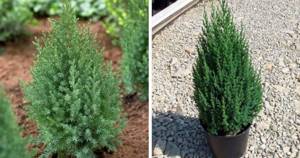
The plant is characterized by small compact size, slow growth rate, at 10 years of age it reaches a height of 2-3 m and up to 1.5 m in diameter.
The shrub has a symmetrical dense crown of a conical shape, represented by a set of straight, thin, fairly rigid shoots growing in a vertical direction relative to the trunk. The needles of the plant are thin, prickly, but at the same time quite soft. In warm periods it has a green-bluish color, and in winter it becomes gray-blue. Feature of the variety
Did you know? In ancient times, dishes were made from juniper wood. In such containers, even in the heat, the milk did not sour and remained sweet and fresh.
The Variegata stricture is the presence of shoots with white and variegated colors, arranged in a chaotic manner, which gives the perennial decorativeness and uniqueness. During the period from August to October, small inedible fruits are formed on the bush - dark blue cones, about 0.8 cm in diameter, on the surface of which a white waxy coating forms. Inside the fruit there are 3 small seeds.
Planting and care
The ideal place for planting must be chosen immediately. Plants older than 4 years do not take root well, but they can live in one place for more than 100 years. Chinese juniper is a light-loving plant: only in good lighting all the color qualities of the needles are revealed. But very bright sun in February-March can lead to burning of the crown.
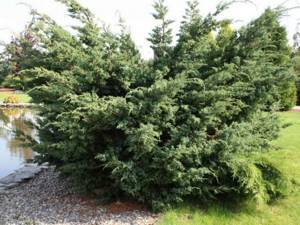
How to choose a site for planting?
- A well-lit area with slight partial shade on the south side.
- Deep groundwater.
- Loose soil, possibly with stones.
- The acidity of the soil should be from neutral to slightly acidic.
According to statistics, plants planted in early spring or autumn, but no later than October, take root better. Bushes with a closed root system can be planted throughout the year. They are pre-soaked in a growth stimulator and it would be nice to treat them with antifungal drugs.
Before planting, dig holes up to 70 cm deep at a distance of 50 cm from each other. The distance between trees can vary, depending on the variety and the intended composition. A 20-centimeter layer of a drainage system made of broken brick, crushed stone or expanded clay must be laid at the bottom. After this, a layer of nutritious soil consisting of peat, sand and turf soil is poured, then the soil is allowed to settle. Young seedlings are placed in a hole, sprinkled with a mixture of soil and fertilizer and watered for 2 weeks. The root collar should be at a height of 10 cm from the ground. The soil around the plant is periodically loosened and mulched to conserve moisture.
Mature plants do not require frequent watering; once a month is enough if the season is very dry and hot.
But dry air can harm the decorative appearance of the crown. In the evening, it is advisable to carry out “sprinkling”, spraying not only the crown, but also the tree trunk.
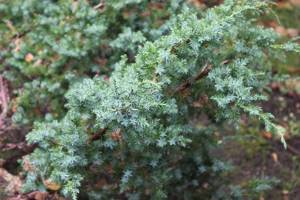
Wintering
Chinese juniper is perfect for growing in central Russia without additional shelter. But in the first year after planting, the plant must be protected from heavy snow, and in the case of a frosty and snowless winter, from drying frost. The trees are covered with spruce branches and special material. Every autumn, juniper bushes are mulched with peat or sawdust to a height of 10 cm.
Trimming
Chinese juniper is suitable for planting as a “hedge”.
It responds well to pruning, allowing you to give the crown a variety of shapes. This only makes it thicker.
The first pruning is carried out in March before the onset of active growth. At this time, the temperature should not be below 4 degrees. The second time pruning is carried out in August. Young shoots should be covered with dense bark before the onset of frost. During pruning, only 1/3 of this year's growth is removed.
Varieties of Chinese juniper
Today, botany includes more than 20 species of Chinese juniper, each of which is characterized by its own properties. Before purchasing a bush, it is important to carefully familiarize yourself with the characteristics of each plant variety, its characteristics and care rules.
Juniper Chinese Spartan
Chinese juniper Spartan is a tree with a cone-shaped crown and a rapid growth rate. At the age of ten years, the plant reaches about 3 m in height, which allows designers to use the Spartan variety to create hedges.
The maximum height of the tree is 5 m with a crown diameter of 2.5 m. The shoots on juniper are located vertically, and the growth rate of branches per year reaches 15 cm in length. The plant has dense needle-shaped needles of light green color.
The Spartan variety is often planted in moderately moist soils. Ephedra has a high level of frost resistance, is undemanding to the soil composition and is photophilous. In addition to creating hedges, gardeners recommend including trees in group compositions, combining them with low-growing species.
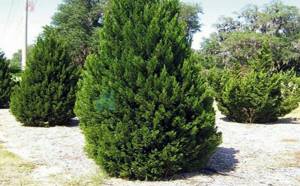
Juniper Expansa Variegata
Chinese juniper Expansa Variegata is a dwarf shrub whose maximum dimensions are 40 cm in height and 1.5 m in width. The shoots of the plant spread down the ground, forming a bright green needle-like carpet. The needles of the Chinese juniper variety Variegata are presented in the form of needles and scales, have a rich green-blue color, and the fruits of the shrub are small (5 - 7 mm) light green cones. The shrub of this variety also has a distinctive feature: some of its needles are painted a soft cream color.
Fans of dwarf plant varieties quite often choose this particular type of Chinese juniper because of the low growth rate of shoots - only 30 cm in 10 years of growth.
The shrub is planted in rocky soil moderately filled with nutrients. It is strictly not recommended to grow the Expansa Variegata variety at home - the plant prefers to spread along the ground, so the best place for its cultivation would be a small summer cottage.
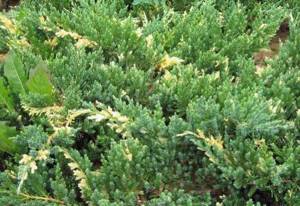
Juniper Blauw
Chinese juniper Blauw is an evergreen, slow-growing shrub with crown-shaped needles. The plant appeared in Europe in the 20s of the twentieth century, when the first shrub seedlings were imported from Japan. Traditionally, the Blauw variety was used to decorate Japanese gardens, and also as an element of ikebana. Its distinctive characteristics are straight shoots growing strictly upward, which gives the shrub its characteristic shape. In the classic description, the maximum height of the Chinese Blowweed juniper is 2.5 m with a crown diameter of 2 m, however, these figures may vary: it all depends on the level of humidity and soil fertility. The plant has scaly needles of a gray-blue color. Ephedra is undemanding to soil; it grows and develops especially well in soils with a neutral or slightly acidic reaction, as well as in alkaline soil. Excellent for planting on city streets, since the level of air pollution has virtually no effect on the condition of the plant. The only enemy of the Blauw variety can be sawflies,
Gardeners recommend combining this variety of juniper with tall types of ornamental crops, placing the shrub in a semi-shaded area.
Important! Stagnation of moisture for the Blauw variety can threaten the death of the plant.
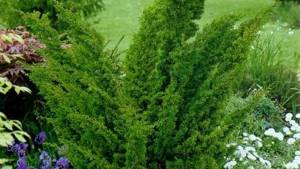
Juniper Blue Haven
Dendrologists consider this variety to be one of the most richly colored shrub species. Chinese juniper Blue Haven is characterized by a conical shape and a dense crown of sky-blue color that persists throughout the year. Landscape designers often use this variety to create hedges, as well as as a vertical element in a garden composition. The needles of the plant have a wide conical shape with raised cylindrical shoots. At maturity, the Blue Heaven variety reaches 5 m in height and more than 2 m in width. The culture has a high level of winter hardiness and prefers sunny or slightly shaded areas. It is not recommended to plant the plant in the shade so that its needles do not become lethargic and loose. The Blue Heaven variety is undemanding to soil and grows well in any well-drained soil, regardless of its level of fertility. Designers use this type of Chinese juniper as a vertical element in creating rock gardens and contrasting landscape compositions.

Chinese juniper Plumosa Aurea
Chinese juniper Plumosa Aurea is especially valued by landscape designers for the rich yellow color of its needles. At the age of 10 years, the plant reaches 1 m in height with a crown diameter of 1 m. Ephedra has a wide spreading crown with slightly asymmetrical feathery branches. The annual growth of the Plumosa Aurea variety is 5 - 8 cm in height and about 10 cm in width. The needles of the plant are scaly, golden-yellow in color, the ends of the shoots hang down slightly. Juniper of this type is often used to create group or single plantings, for landscaping alpine hills, rockeries, and also for rocky slopes.
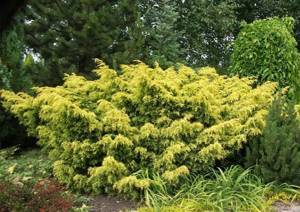
Juniper Monarch
Description of the variety: Chinese Monarch juniper is a tall, monochromatic tree with an irregular columnar-shaped crown and dense needles. The growth rate of the plant is slow, it can reach a maximum of 3 m in height and 2.5 m in width. Ephedra is most often used to form hedges, as well as as a central figure in the garden. The Monarch variety has prickly needles colored bluish-green, which from a distance is perceived as a pure blue color. Not picky about lighting, the plant can be grown both in sunny places and in semi-shaded areas. The tree is undemanding when it comes to planting soil and watering, but does not tolerate drafts: they can provoke the appearance of various diseases and the death of the conifer. This variety of Chinese juniper requires only sanitary pruning: there is no need to constantly trim growing shoots.

Juniper Obelisk
According to the description, the Obelisk juniper is a tall tree with an irregularly shaped crown, which smoothly transitions from narrow-conical to wide. At the age of 10 years, the height of the plant is 3 m. The variety has hard awl-shaped needles covered with a blue coating. Ephedra is undemanding to soil and watering; it grows best in sunny places, but in shaded areas it becomes dry and loose. Sanitary pruning of the plant is carried out in the spring, after which the juniper should be treated with a fungicide to protect against fungal diseases. Important! Experts do not recommend cutting off more than 1/3 of the growth.
The crop does not require shelter for the winter, however, at the end of autumn, the branches of the plant should be tied together to prevent injury to the crown due to the severity of the snow cover.
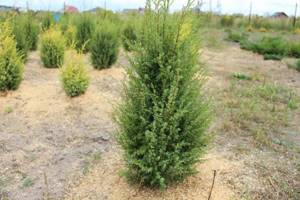
Juniper Kaizuka
Chinese juniper Kaizuka (Kaizuka) is an evergreen coniferous plant with an unusual color of needles, changing in color from green to dark blue. At the ends of the branches there are rich beige spots. The branches of the plant are located horizontally, parallel to the ground. The crown has an irregular shape, with shoots differing in length. In adulthood, it reaches more than 5 meters in height with a crown diameter of 2 m. The Kaizuka variety has needle-shaped, prickly needles with a rich green color in the middle of the needles and a silver-blue tint at the ends. Some of the plant's needles are beige in color, which makes the plant more exotic. The root system of the tree is branched, the variety does not tolerate soil with a high salt content, which is why black soil is considered the best soil for planting it. Designers often call this variety “apple juniper” because the beige spots on the body of the plant really resemble these fruits. The small height of the tree allows Kaizuka juniper to be used to create low and medium-sized hedges. The plant will serve as an excellent decoration for both single flower beds and complex compositions.

Juniperus chinensis Keteleri
Chinese juniper Keteleri is a fast-growing, tall coniferous tree, reaching more than 5 m in height when mature. The plant is characterized by an upright, dense, columnar-shaped crown with branches arranged vertically and a special coniferous aroma. The Keteleri juniper variety has scaly needles pointed at the ends of a bright green color with a bluish waxy coating.
Gardeners recommend planting the plant in well-lit areas, while the ephedra normally tolerates slight shading. It grows and develops better on fertile, moderately moist, drained soil and has a high level of frost and wind resistance.
The culture is used to create evergreen hedges, group compositions and looks especially good in combination with golden-yellow conifers, as well as separately on a green lawn.
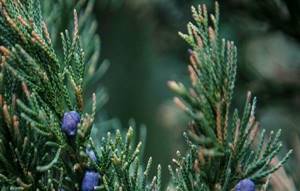
Juniper chinensis Expansa Aureospicata
Chinese juniper Expansa Aureospicata is a low-growing, slow-growing dwarf shrub with a wide, spreading crown and shoots spreading horizontally along the ground. In adulthood, it reaches 30 - 40 cm in height with a crown width of up to 1.5 m. The annual growth of the plant is up to 10 cm in width. It grows better in sunny areas; shaded areas can provoke a loss of decorative qualities of the crown. Chinese juniper Expansa Aureospicata will be a good addition to the design of rocky gardens and oriental-style gardens.
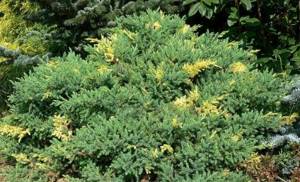
Juniperus chinensis Pfitzeriana
Chinese juniper Pfitzeriana is characterized by a slow growth rate - up to 15 - 20 cm per year. At the age of 10 years, the plant reaches 1 m in height, and the maximum size of the shrub is about 2 m in height with a crown diameter of 3 - 4 m. Chinese juniper Pfitzeriana has an outstretched crown shape, which then rises slightly with hanging ends of the shoots. When young, the shoots are golden yellow, which becomes bright green over the years.
The variety is actively used in landscape design for creating bonsai and decorating rocky walls.
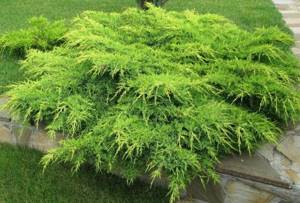
Juniperus chinensis Blue and Gold
Chinese juniper Blue and Gold is one of the most original ornamental shrubs with an unusual crown shape, consisting of shoots of blue and yellow colors. At the age of 10 years, the plant reaches about 0.8 m in height with a crown diameter of 1 m. The crown of the bush is spreading, with an irregular shape. Ephedra is endowed with bright phytoncidal, insecticidal and bactericidal properties.
It is undemanding to soil and moisture, develops better in illuminated spaces, and in shaded areas it may lose color contrast. This Chinese juniper has a high level of frost resistance.
Blue and Gold seedlings are equally suitable for both small areas and large garden and park contrasting compositions that can decorate city lawns.
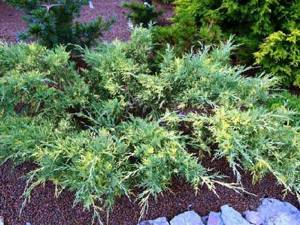
Juniperus chinensis Gold Coast
Chinese Gold Coast juniper is an evergreen, fast-growing conifer with a dense spreading crown of golden-green color. In adulthood, it usually reaches 1 m in height with a diameter of 2 m. The annual growth of the shrub is about 10 - 15 cm. During the period of active growth, horizontal shoots with drooping ends have a bright yellow color, which darkens over time and acquires a golden hue. The fruits of the plant are represented by small round-shaped cones. The shrub is undemanding to the soil, prefers illuminated areas: in shaded areas it develops much worse, losing its color. The plant is resistant to severe frost, dry periods and active spring sun.
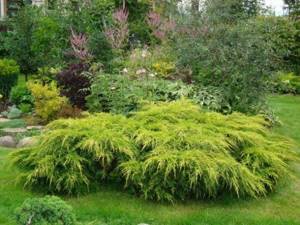
Juniperus chinensis Dubs Frosted
Chinese juniper Dubs Frosted is a slow-growing cushion-shaped shrub with a spreading crown. It is considered one of the most valuable varieties of low-growing juniper. In adulthood, it reaches 0.4 - 0.6 m in height with a crown diameter of 3 - 5 m. A distinctive feature of the species is its bright yellow color of needles, which changes to dark green over time. The Dubs Frosted variety is a light-loving plant, which, however, feels quite comfortable in semi-shaded areas. When planting, it is best to choose moist, well-drained soil. Ephedra needs regular watering. It is actively used by designers to create both complex garden compositions and single plantings.
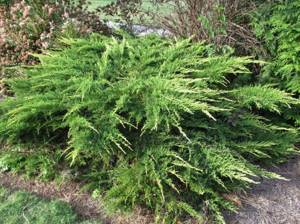
Juniperus chinensis Torulosa Variegata
Chinese juniper variety Torulosa Variegata is distinguished by a conical dense picturesque crown of irregular shape. The branches of the plant are in an elevated state and are evenly spaced. The shoots are straight and short. The shrub has prickly blue-green needles; shoots of a white-variegated hue can often be seen on the plant.
The growth rate is slow, in adulthood the shrub reaches 2 m in height with a crown diameter of 1.5 m, annual growth is up to 10 cm. It is unpretentious to the soil, has a high level of frost resistance, grows better in sunny areas, and loses its rich color in the shade . The Chinese juniper variety Torulosa Variegata will perfectly complement the design of a rocky garden or rock garden.
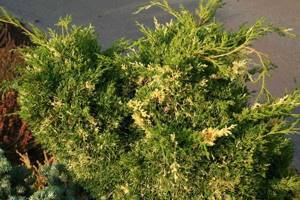
Diseases and pests
Most often, junipers suffer from fungi caused by waterlogging of the soil. It is found in the soil and is activated by high humidity, causing the death of the plant. First, the roots turn black, then the fungus clogs the vascular system and the bush begins to dry out from the top. It is not possible to cure the plant; it is better to destroy it and completely replace the soil in this place. The disease is especially common in young seedlings that need regular watering.
Juniper rust manifests itself in the appearance of brown thickenings on the branches. This fungus requires two hosts, one of which is an apple, pear or hawthorn tree. On these trees it appears as voluminous spots on the leaves. If signs of disease are detected on the juniper, the damaged branches must be trimmed with sterile pruners and destroyed.
Be sure to treat both plants with fungicide.
Brown and yellow needles may be a sign of Alternaria blight. A black coating is visible on the browned needles. The cause of the disease can be very dense planting and insufficient ventilation between trees. At first, only the lower branches are affected, then the entire plant may die. The affected parts of the bush must be removed and all fallen needles collected from the ground.
You can avoid the spread of Alternaria blight by using high-quality planting material, treating cuts on the plant with disinfectant solutions and carrying out timely preventive procedures.
For this purpose, such drugs as Hom, Topaz and Abiga-pik are recommended.
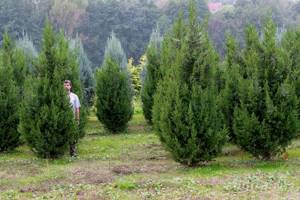
Among insects, damage to juniper can be caused by the moth, juniper scale insect and gall midges. Insects are visible to the naked eye, the plant begins to wither and die. When processing, you should water not only the bush, but also the soil around it, since insect larvae at different stages of development are in the soil. It is for this reason that the procedure must be repeated within two weeks.
Juniper beetle can damage the integrity of the bark: its passages can be easily seen on the trunk. You can fight it by treating the plant with Fufanon and Actellik. Aktellik is buried in the passages undiluted.
Red ants and snails also cause damage to the bush. Special and complex insecticides have been developed for them, which can be purchased at garden centers.
How to propagate?
There are several ways to propagate Chinese juniper.
The most popular method among gardeners is cuttings. It allows you to obtain a certain number of cuttings in a fairly short period of time. The material is collected in February. Young but already bark-covered shoots are suitable for this. Select cuttings from 7 to 25 cm with two or more internodes.
The cuttings are not cut off; it would be more correct to tear them off so that the so-called “heel” (part of the trunk with bark) remains at the end.
The lower part is cleared of branches and needles and dipped in Kornevin. Boxes prepared in advance are filled with a mixture of sand, humus and peat in equal proportions. The branches are inserted to a depth of 2 cm. The seedlings are taken out to a well-lit place in boxes covered with film (like greenhouses), regularly watered and sprayed. It can be transplanted into open ground only after 1-2 years.
Another simple method of propagation is by layering. More suitable for horizontal varieties. To do this, the soil around the plant is loosened and supplemented with sand and peat. The side shoot is cleared of bark in several places and pressed with pins. Sprinkle soil on top. Regular and moderate watering is required. The young plant can be separated from the mother bush the very next year. When new vertical shoots appear, the bush is planted in a permanent place.
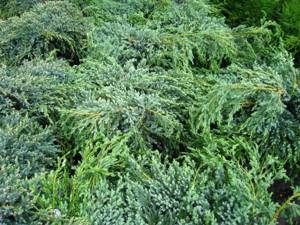
The most labor-intensive method of propagation is by seeds. It allows you to get the maximum number of young, healthy plants. Only cones covered with a dark (almost black) shell are suitable for seeds. The seeds in them are already ripe.
Grind the berry cones and pour the seeds into a glass of water. You can add a growth stimulator. Ripe seeds sink, and seeds from which nothing will grow float.
Seeds must undergo stratification. You can artificially create conditions with a decrease in temperature, or you can plant it in the fall and put the box outside, covering it with snow. The soil should consist of peat, humus and sand, and it is also recommended to add some soil from under the coniferous trees of the garden. The soil contains fungi - symbionts, which allow the root system to develop better.
The first shoots appear only after 3 years. They need special care unlike an adult plant. Seedlings require regular watering, loosening the soil and shelter from direct sunlight. When the plants reach three years of age, they are planted in open ground in a permanent place. The trees are first hardened off.
Use in landscape design
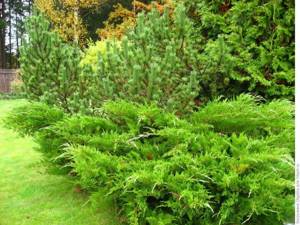
Landscape designers have long loved this plant for the ability to modify its crown using pruning and excellent hardiness in the middle zone. Chinese juniper forms a beautiful cascade of greenery on rockeries. It can be used as a “hedge” and individual tapeworms against the backdrop of lawns. Like all conifers, it will not lose its attractiveness in the winter season. Can act as a background for perennial ornamental flowering and ornamental foliage plants. This species is grown as a bonsai, giving the trunk beautiful bends.
Chinese juniper is an excellent garden plant that can decorate the garden for many decades. The shrub does not require fertile soils and can even grow on stones. It is so easy to clean that even a beginner can handle it.

